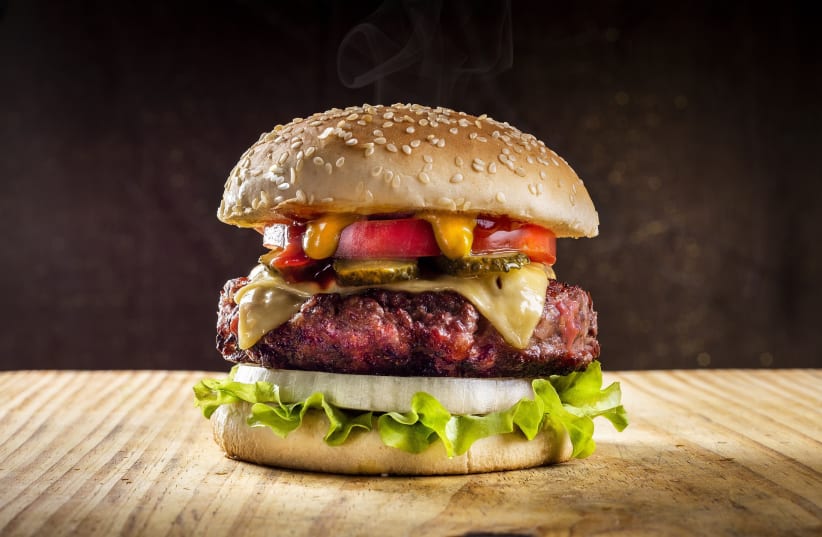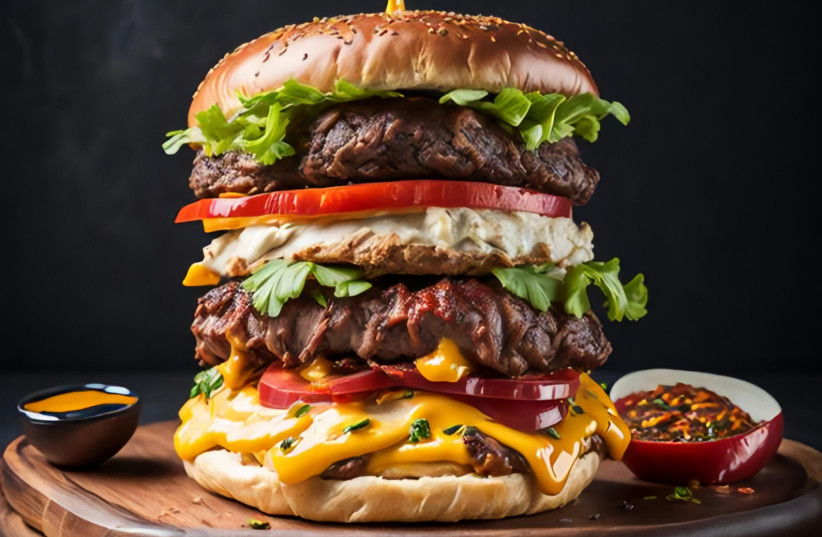The hamburger has found its niche within the Israeli diet and can now be found everywhere from fast food chains and higher-end restaurants. The combination of flavors from the meat patty, the bread buns, the toppings and various sauces has made it a favorite among Israelis of all ages.
But is a hamburger considered junk food, meaning you shouldn't have too much of it, or is it safe to have it without any risk to your health?
And if you want to lose weight, how often can you enjoy a burger?
Just as a hamburger is made of several parts, so is the answer to this question. So, let's break this down into its different components.
Decisions, decisions: Choosing your meat
Hamburger patties are made of ground meat, which can be anything from beef or lamb to chicken, or any other type of meat. The fattier the type of meat, the higher its caloric value.
Lean beef is considered a protein with high nutritional value. Aside from being high in protein, it also contains essential minerals for the body such as zinc, iron and vitamin B12. Lean beef cuts are designated by the following numbers:
- 3 - brisket
- 4 - silver tip roast
- 5 - minute steak roast
- 6 - petit tender
- 11 - sirloin
- 12 - tenderloin
- 13 - rump
Having said that, using just lean beef in a hamburger comes with its own issues. If a hamburger is only made with lean cuts, it will come off the grill dry and with a rubbery texture. Because of this, you should try to mix fat and lean cuts of meat together.
A 150-gram hamburger patty with medium fat tends to be around 200-250 calories.
Preparing the hamburger patty
Usually, you'd prepare your hamburger patty on the grill. This has advantages, because it keeps the juices in the patty, keeping it juicy.
The duration of grilling is very important, too. Grilling for too long will dry the meat out, which will ultimately get rid of a large part of its nutritional value, such as vitamins and minerals.
Hamburger toppings and side dishes
Toppings and side dishes for burgers vary, ranging from vegetables to other types of sauces and carbs.
If it's just vegetables or different kinds of pickles (preferably pickles with less salt) then it actually would be somewhat healthy.
It is also important to take into account the sauces, which add calories of their own. In particular, mayonnaise and barbecue sauce are rich in both fat and sugar, with one serving of each adding around 200 calories.
Some common side dishes for burgers are carbs, including french fries (or chips, for non-American readers), onion rings, potatoes and potato wedges. Just a small portion of one of these can contain at least 200 calories, both because of the carbs themselves and because of the sheer amount of oil from frying them.
But even without any of these side dishes, hamburgers are already heavy on carbs due to the buns, so side dishes add even more.
In addition, eating a lot of salt – which tends to happen with french fries – can have a negative impact on blood pressure for some people due to it causing a temporary accumulation of fluids.
The buns
A hamburger with buns and vegetables without sauces or side dishes has around 500 calories on average and half of these come from the carbs in the bun and not the meat.
Most buns are large and are basically the equivalent of four slices of bread, so they could add around 250 calories on average.
For those who need to maintain a low-carb diet, such as diabetics, this sort of meal is less than ideal.
So what's the solution? Make your own hamburger at home, using a smaller bun with fewer carbs. Not only that, but you can also buy low-carb or gluten-free buns.
Overall, if you calculate everything from the patty to the toppings, bun and side dishes, you;'ll find that a hamburger ordered from a restaurant or fast-food eatery can contain over 1,000 calories, with high levels of fat and carbs.
What about a homemade hamburger?
Making your own hamburger at home means you have far more control over its nutritional value.
Use ground meat with moderate fat levels, grill without oil, use reasonable amounts of salt and limit the size of the patty and buns. Use homemade sauce without any preservatives.
Diversify toppings with different fresh, baked vegetables and eat a salad at the start of the meal.
If you do this, it could cut the number of calories down by half, and it also comes with good nutritional values with lower fat and carb levels.
Homemade hamburger recipe
- 50-gram hamburger bun
- 150 grams of fresh ground beef with moderate fat levels
- 1 teaspoon of mayonnaise
- 1 teaspoon of ketchup
- 1 teaspoon of mustard
- 2-3 tomato slices
- 2 fresh lettuce leaves
- 2-3 purple onion slices
- Salt and pepper to season only the outside of the patty
Instructions:
- Knead the minced meat for only 2-3 minutes, no more than that. Form the beef into a burger patty.
- Heat up a plancha pan and spray it with a small amount of oil spray.
- Put the patty on the pan and season it with salt and freshly ground pepper. Grill it until the edges change color. Flip it to the other side and grill for a few more minutes. Checking the patty's center can tell you how much it's been grilled so far. We recommend removing it when the center is still a bit soft.
- If you want, you can warm up the inside of the bun on the plancha for a few minutes.
- Spread the mayonnaise and ketchup on the inside of the bun and place the patty on top of it. Add the vegetables on top of the patty and then the other bun on top of them.
Nutritional values per serving:
- Around 460 calories
- 30 grams of protein
- 26 grams of carbs
- 12 grams of fat
- 1.5 milligrams of vitamin B12 (half of what an adult needs each day)
- 1.75 milligrams of iron
- 4/95 milligrams of zinc (half the daily intake needed for women, and a third of the daily intake needed for men)
You can eat a hamburger like this once every now and then since the nutritional value isn't too bad. If you find a place that prepares it like this, it's fine to have it every few months or so.
Alternatively, prepare it yourself at home and you can have a hamburger once a week.
Niora Marta is a clinical dietitian at Heli Mamen


